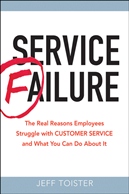Resorting to extorting isn't good service
 Jeff Toister
Jeff Toister  Monday, May 9, 2011 at 9:55AM |
Monday, May 9, 2011 at 9:55AM | You can call it what you want, but extortion is extortion. Telling your customer, "that's how our system works" doesn't mean you can charge for additional services in return for fixing what your customer has already paid for.
Last weekend, I experienced an extortion attempt when I called a 1-800 number for customer service. I don't want to name the company in case their goons try to track me down, so let's just say it was a major satellite radio provider.
Here's a short video re-enactment of my customer service experience. (View it here if it doesn't appear on your screen.)
This may sound cliche, but I really don't blame the six employees I spoke to. I blame the system. Specifically, there are four major problems I identified during my ordeal. Hopefully, your company doesn't have any of them but it would be wise to double-check.
Problem #1: Interactive Voice Response
Interactive voice response, or IVR, is that annoying feature that allows you to speak commands or questions rather than pushing buttons on your phone for various options. It's annoying because it rarely works. Nothing tells a customer you hate them like making them deal with an incompetent robot before they get to speak with a real person.
Problem #2: Service silos
If you are a regular reader, you already know how I feel about service silos. No customer wants to interact with an employee who has a bad case of that's-not-my-jobitis. It usually means you get passed along to someone else who may or may not be able to help you. In my case, I had to speak with six different employees before I could get a solution.
Problem #3: Blind transfers
A blind transfer is when a call center agent transfers your call to another department's phone queue rather than directly to another person. This means the person who answers the phone doesn't know what you are calling about and you have to re-explain the problem. Speaking to six different agents means I had to repeat the problem six times. The more you talk about it the more frustrating it becomes.
Problem #4: Extortion
They really did try to extort money from me. I was told by two separate employees that they could fix the problem and restore my traffic updates if I paid for a year of service. I had already paid for a year of satellite radio service in March, so paying for another year two months later seemed ridiculous. The traffic update service is an extra add-on, but I had just paid for that on May 1. That didn't stop this company from trying to tell me the only way to fix my service was to charge me for another year.
Don't worry, my service has been restored. And, I didn't have to spend much time this week dreaming up blog topics. In that sense, I guess I win.





